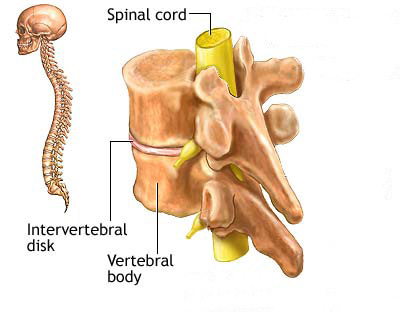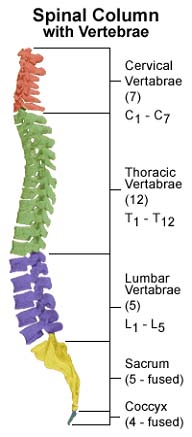The spinal cord consists of nerves that connect the brain to nerves in the body. It is a superhighway for messages between the brain and the rest of the body. The spinal cord is surrounded for most of its length by the bones (vertebrae) that form the spine. There are:
31 pairs of spinal nerves connect with the spinal cord through nerve roots and travel to specific parts of the body. For example, the pair of spinal nerves connecting with the spinal cord in the region of the C2 vertebra travel to the head and neck, while the spinal nerves attaching to the cord in the region of the L4 vertebra run to specific muscles in the legs and specific areas of skin in the calves. The diagram below indicates where in the body the spinal cord nerves extend to.

The spinal cord is surrounded by the bony vertebrae, which usually protect the soft spinal cord from injury. The cord runs through the oval shaped opening in the vertebra seen in the diagrams. The vertebrae are stacked on top of each other and separated by spongy "discs" that act as shock absorbers for the spine.


However, if a vertebra is broken and a piece of the broken bone presses into the soft spinal cord (it has the consistency of toothpaste), the cord will be injured. The cord can also be injured if the vertebrae, which are normally held in place by strong ligaments and muscles, are pushed or pulled out of alignment (called subluxation), even if the vertebrae are not fractured. The diagram below shows a broken vertebra pressing on the spinal cord (the view in the diagram shows the broken vertebra cut in half to reveal the spinal cord).

The level of the spinal cord injury refers to the vertebra that the injury is closest to. For example, an injury to the spinal cord at the level of the sixth cervical vertebra would be referred to as a C6 injury (“C” for cervical). An injury to the cord between the C6 and C7 vertebrae would be called a C6-7 injury. A T12 injury occurs at the level of the 12th thoracic (T) vertebrae. An L3 injury occurs at the level of the third lumbar (L) vertebra, and so on.
When the spinal cord is injured, the ability of the brain to communicate with the body below the level of the injury may be reduced or lost altogether. This results in diminished capabilities in those areas and possibly partial or complete paralysis.
The higher (closer to the head) the spinal cord injury is, the greater the area of the body that may be affected. For example, a man with a T10 injury (at the level of the 10th thoracic vertebra, which is in the lower middle back) may lose use of his legs (paraplegia) but his arms will not be affected. A woman with a C4 injury (at the level of the 4th cervical vertebra, which is in the middle of the neck) may lose use of her legs and a rms (referred to as tetraplegia or quadriplegia).
An incomplete injury means that the person has some function below the level of the injury, but that function isn’t normal. For example, a person might have weakness of the arms but still be able to move them. Another person may lose the ability to use muscles below the level of the injury only on one side of the body while losing pain and temperature sensation on the other side of the body.
Some doctors use a very technical definition for an “incomplete” injury. The International and American Spinal Injury Association (ASIA) defines an incomplete spinal cord injury as one in which the person has some spinal cord function preserved below the sacrum (below S5).
A complete injury means that there is complete loss of sensation and muscle control below the level of the injury. Almost half of all spinal cord injuries are complete. Most spinal cord injuries, including complete injuries, result from bruising of the spinal cord or loss of blood flow to the cord and not from cutting of the cord. A complete injury does not mean that there is no hope of any improvement (see the treatment page).
Whenever a person has experienced significant trauma to the head or neck, a spinal cord injury must be suspected until proven otherwise. Precautions are taken by medical personnel to immobilize the spine (with a backboard and neck collar) until a physician has performed an examination. X-rays of the spine can look for any damage to the vertebrae (X-rays are good at showing bones but not soft tissues such as the spinal cord). If a patient has symptoms or findings of a spinal cord injury, a CT scan or MRI will be performed. Those scans show much more detail than an X-ray. See page on imaging techniques for spinal cord injury diagnosis.

 CT scans are usually better than MRIs
at showing bones, while MRIs are usually better at showing soft tissues.
The black arrow in this CT scan points to a fractured vertebra, which
is seen in a side view. The breaks are visible in the bone. The broken
vertebra is out of alignment with the vertebrae above and below it.
It is pressing in on the spinal cord, which is the gray matter between
the light colored “body” of the vertebra on the left in
the image (the large light colored bone) and the smaller posterior
(furthest back) portion of the vertebra on the right.
CT scans are usually better than MRIs
at showing bones, while MRIs are usually better at showing soft tissues.
The black arrow in this CT scan points to a fractured vertebra, which
is seen in a side view. The breaks are visible in the bone. The broken
vertebra is out of alignment with the vertebrae above and below it.
It is pressing in on the spinal cord, which is the gray matter between
the light colored “body” of the vertebra on the left in
the image (the large light colored bone) and the smaller posterior
(furthest back) portion of the vertebra on the right.
While the level of a spinal cord injury is diagnosed when a patient is first admitted to the hospital, the level at which the survivor will be functioning after rehabilitation and therapy is likely to be better than the level at diagnosis (see the treatment section).

